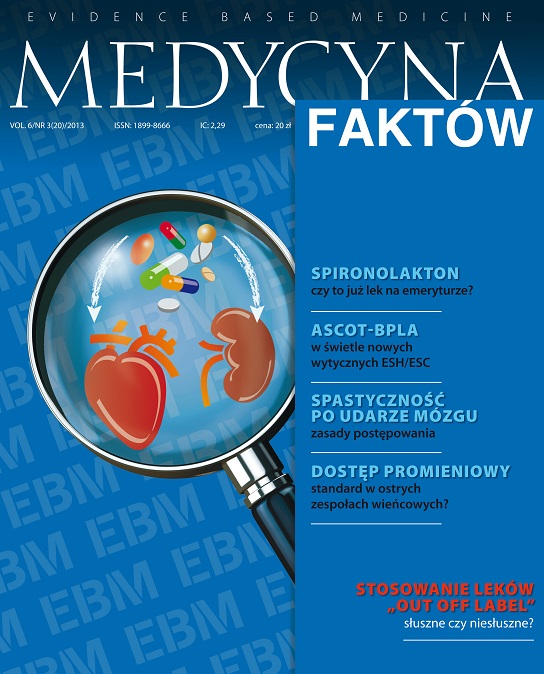Radial approach for the invasive management of acute coronary syndromes Review article
Main Article Content
Abstract
Invasive treatment of acute coronary syndromes improved prognosis, while increasing the risk of vascular complications and bleeding. The recently published study show that radial approach compared to femoral access improves hemostatic efficacy, reduces major bleedings and local complications. Radial approach is more comfortable for the patient and reduces immobilization time. The advantage of radial approach for invasive treatment of acute coronary syndromes has been demonstrated in clinical trials and has found its place in the recently published guidelines.
Article Details
How to Cite
Chmielewski , M., & Janiszewski , M. (2013). Radial approach for the invasive management of acute coronary syndromes. Medycyna Faktow (J EBM), 6(3(20), 66-71. Retrieved from https://journalsmededu.pl/index.php/jebm/article/view/2408
Issue
Section
Articles
Copyright ? by Medical Education. All rights reserved.
References
1. Kiemeneij F., Laarman G.J., Slagboom T., van der Wieken R.: Outpatient coronary stent implantation. J. Am. Coll. Cardiol. 1997; 29: 323-337.
2. Beygui F., Montalescot G.: Rozdział 29: Wykorzystanie dostępu promieniowego podczas przezskórnych interwencji wieńcowych w celu zmniejszenia częstości występowania powikłań krwotocznych. W: Kardiologia Interwencyjna. Tom 2. Topol E.J. et al. (red.). Urban & Partner, 2011: 564.
3. Louvard Y., Benamer H., Garot P. et al.: Comparison of transradial and transfemoral approaches for coronary angiography and angioplasty in octogenarians (the OCTOPLUS study). Am. J. Cardiol. 2004; 94: 1177-1180.
4. Barbeau G.R., Arsenault F., Dugas L. et al.: Evaluation of the ulnopalmar arterial arches with pulse oximetry and plethysmography: comparison with the Allen?s test in 1010 patients. Am. Heart J. 2004; 147(3): 489-93.
5. Jolly S.S., Yusuf S., Cairns J. et al.: Radial vs. femoral access for coronary angiography and intervention in patients with acute coronary syndromes (RIVAL): a randomised, parallel group, multicentre trial. Lancet 2011; 377: 1409-1420.
6. Romagnoli E., Biondi-Zoccai G., Sciahbasi A. et al.: Radial vs. femoral randomized investigation in ST-elevation acute coronary syndromes: The RIFLE-STEACS study. J. Am. Coll. Cardiol. 2012; 60(24): 2481-9.
7. Bernat I., Abdelaal E., Plourde G. et al.: Early and late outcomes after primary percutaneous coronary intervention by radial or femoral approach in patients presenting in acute ST-elevation myocardial infarction and cardiogenic shock. Am. Heart J. 2013; 165(3): 338-43.
8. Hamm C.W., Bassand J.P., Agewall S. et al.: ESC Guidelines for the management of acute coronary syndromes in patients presenting without persistent ST-segment elevation, The Task Force for the management of acute coronary syndromes (ACS) in patients presenting without persistent ST-segment elevation of the European Society of Cardiology (ESC). Eur. Heart J. 2011; 32(23): 2999-3054.
9. Chase A.J., Fretz E.B., Warburton W.P. et al.: Association of the arterial access site at angioplasty with transfusion and mortality: the M.O.R.T.A.L study (Mortality benefit Of Reduced Transfusion after percutaneous coronary intervention via the Arm or Leg). Heart 2008; 94: 1019-1025.
10. Agostoni P., Biondi-Zoccai G.G., de Benedictis M.L. et al.: Radial versus femoral approach for percutaneous coronary diagnostic and interventional procedures; systematic overview and meta-analysis of randomized trials. J. Am. Coll. Cardiol. 2004; 44: 349-356.
11. Steg P.G., James S.K., Atar D. et al.: ESC Guidelines for the management of acute myocardial infarction in patients presenting with ST-segment elevation; The Task Force on the management of ST-segment elevation acute myocardial infarction of the European Society of Cardiology (ESC). Eur. Heart J. 2012; 33(20): 2569-619.
2. Beygui F., Montalescot G.: Rozdział 29: Wykorzystanie dostępu promieniowego podczas przezskórnych interwencji wieńcowych w celu zmniejszenia częstości występowania powikłań krwotocznych. W: Kardiologia Interwencyjna. Tom 2. Topol E.J. et al. (red.). Urban & Partner, 2011: 564.
3. Louvard Y., Benamer H., Garot P. et al.: Comparison of transradial and transfemoral approaches for coronary angiography and angioplasty in octogenarians (the OCTOPLUS study). Am. J. Cardiol. 2004; 94: 1177-1180.
4. Barbeau G.R., Arsenault F., Dugas L. et al.: Evaluation of the ulnopalmar arterial arches with pulse oximetry and plethysmography: comparison with the Allen?s test in 1010 patients. Am. Heart J. 2004; 147(3): 489-93.
5. Jolly S.S., Yusuf S., Cairns J. et al.: Radial vs. femoral access for coronary angiography and intervention in patients with acute coronary syndromes (RIVAL): a randomised, parallel group, multicentre trial. Lancet 2011; 377: 1409-1420.
6. Romagnoli E., Biondi-Zoccai G., Sciahbasi A. et al.: Radial vs. femoral randomized investigation in ST-elevation acute coronary syndromes: The RIFLE-STEACS study. J. Am. Coll. Cardiol. 2012; 60(24): 2481-9.
7. Bernat I., Abdelaal E., Plourde G. et al.: Early and late outcomes after primary percutaneous coronary intervention by radial or femoral approach in patients presenting in acute ST-elevation myocardial infarction and cardiogenic shock. Am. Heart J. 2013; 165(3): 338-43.
8. Hamm C.W., Bassand J.P., Agewall S. et al.: ESC Guidelines for the management of acute coronary syndromes in patients presenting without persistent ST-segment elevation, The Task Force for the management of acute coronary syndromes (ACS) in patients presenting without persistent ST-segment elevation of the European Society of Cardiology (ESC). Eur. Heart J. 2011; 32(23): 2999-3054.
9. Chase A.J., Fretz E.B., Warburton W.P. et al.: Association of the arterial access site at angioplasty with transfusion and mortality: the M.O.R.T.A.L study (Mortality benefit Of Reduced Transfusion after percutaneous coronary intervention via the Arm or Leg). Heart 2008; 94: 1019-1025.
10. Agostoni P., Biondi-Zoccai G.G., de Benedictis M.L. et al.: Radial versus femoral approach for percutaneous coronary diagnostic and interventional procedures; systematic overview and meta-analysis of randomized trials. J. Am. Coll. Cardiol. 2004; 44: 349-356.
11. Steg P.G., James S.K., Atar D. et al.: ESC Guidelines for the management of acute myocardial infarction in patients presenting with ST-segment elevation; The Task Force on the management of ST-segment elevation acute myocardial infarction of the European Society of Cardiology (ESC). Eur. Heart J. 2012; 33(20): 2569-619.

